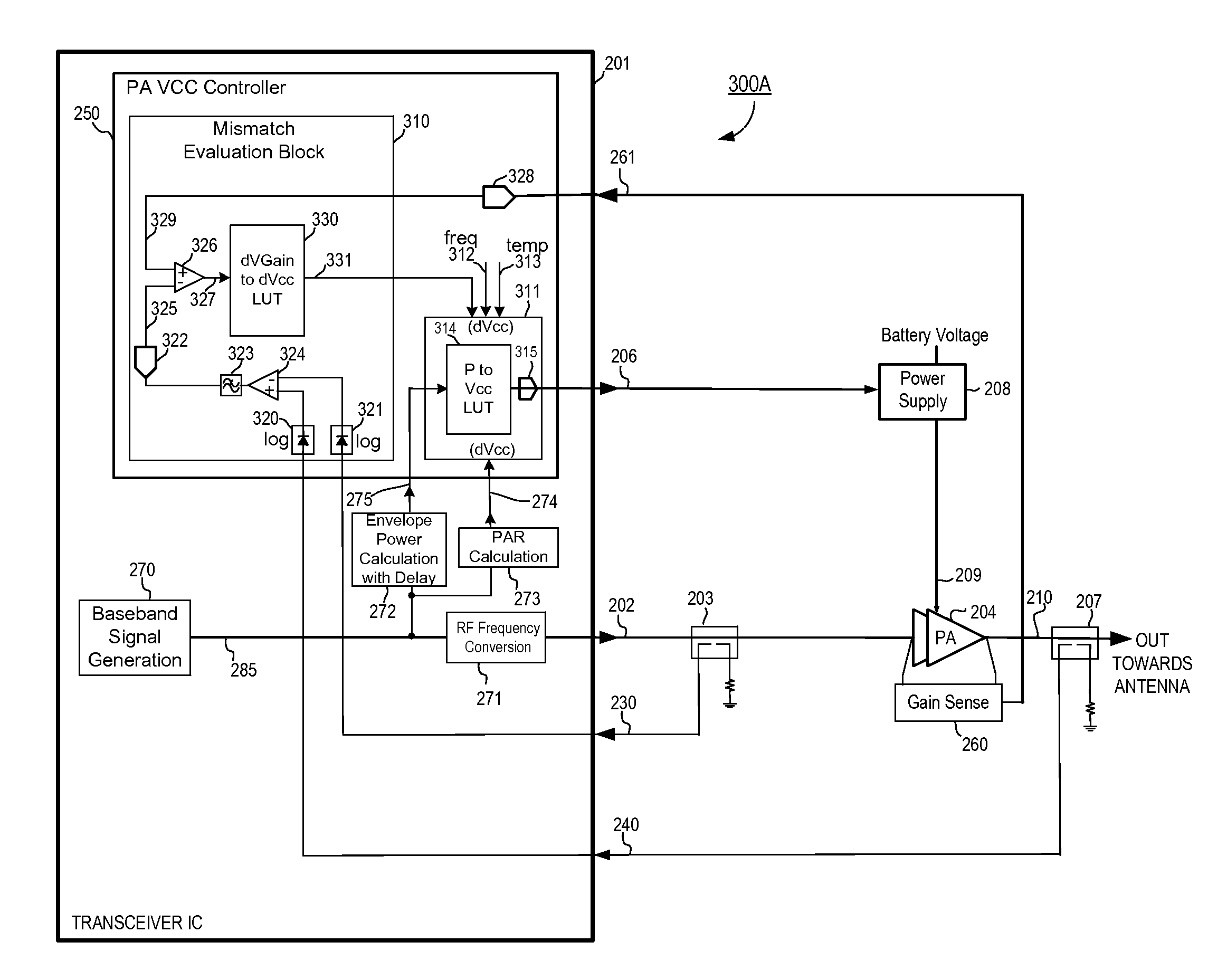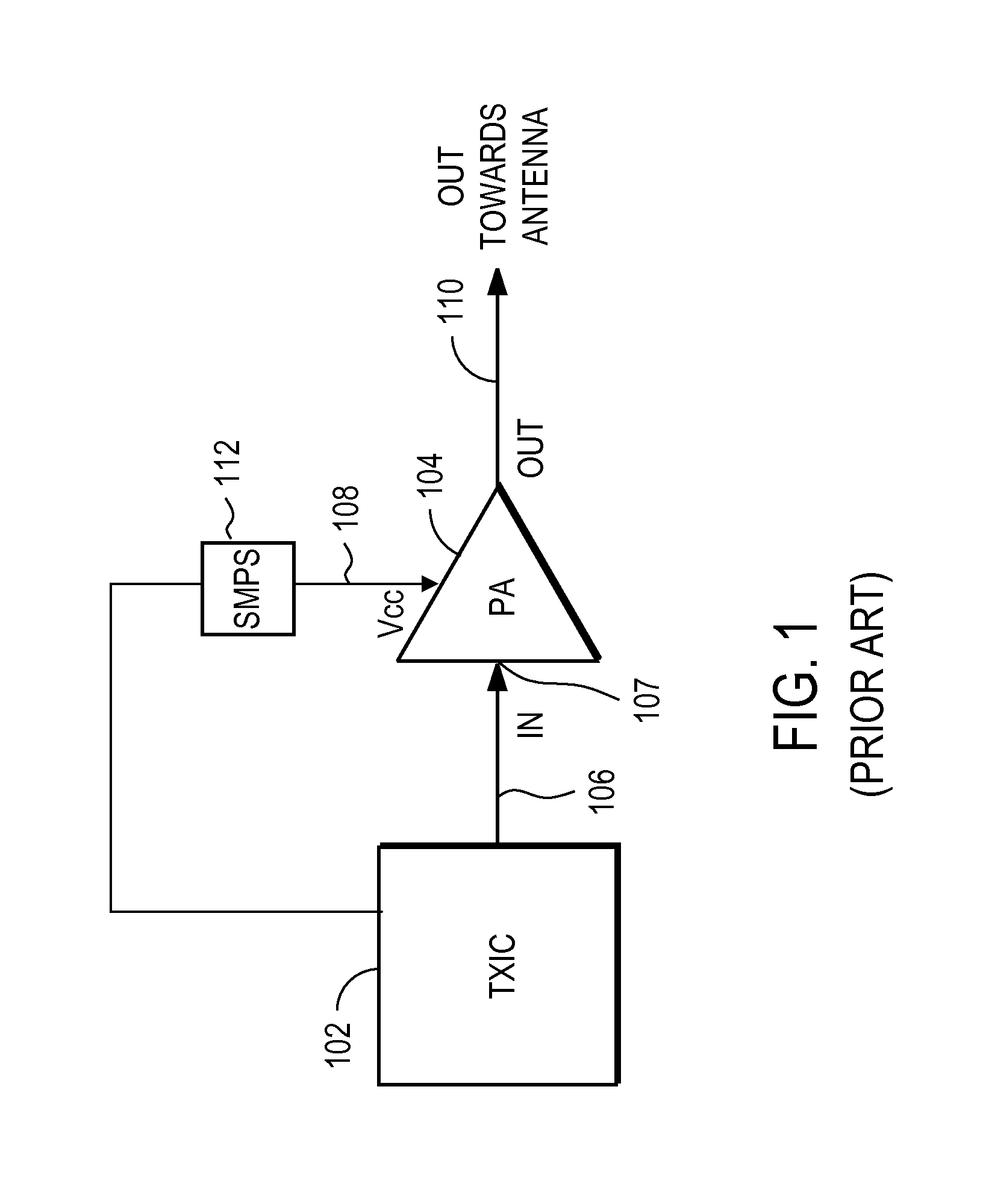RF power amplifier circuit with mismatch tolerance
a power amplifier and mismatch tolerance technology, applied in the direction of amplification control details, high frequency amplifiers, gain control, etc., can solve the problems of sacrificing more power efficiency, affecting the efficiency of pa, and undesirable wide spectral occupancy, etc., to achieve the effect of improving pa efficiency
- Summary
- Abstract
- Description
- Claims
- Application Information
AI Technical Summary
Benefits of technology
Problems solved by technology
Method used
Image
Examples
first embodiment
[0041]FIG. 3A illustrates an RF PA system 300A that includes the details of the PA VCC controller according to the present invention. Specifically, FIG. 3A illustrates the operation of mismatch evaluation block 310, the generation of mismatch indicator signal 331, and the Vcc control block 311 in more detail. “Mismatch” in this context refers to the impedance mismatch seen at the output 210 of PA204. The antenna circuitry following PA 204 typically has nominal impedance around the range of 50 ohms. However, the impedance of the antenna circuitry can sometimes change radically from the nominal impedance. For example, if the antenna is touched or the cellular device is laid down on a metal surface, the impedance of the antenna changes, reflecting impedance changes back to the output 210 of PA 204. The changes in the impedance of the antenna circuitry coupled to the output 210 of the PA 204 may necessitate changes in the VCC supply voltage 209 to the PA 204 to prevent distortion of the...
second embodiment
[0046]FIG. 3B illustrates an RF PA system that includes the details of the PA VCC controller according to the present invention. The RF PA system 300B of FIG. 3B is a variation to the RF PA System 300A shown in FIG. 3A. In this case, VCC control block 310 is configured to respond directly to the measured power envelope of the output signal 210 of PA 204 through forward sampled power signal 240 from directional coupler 207, as indicated by envelope detector 2720, rather than responding to an estimate of the power envelope of output signal 210 utilizing the calculations made with envelope power calculation block 272, as described earlier with reference to FIG. 3A. In this example, envelope detector 2720 tracks the instantaneous power envelope of the RF output signal 210 of PA 204. Thus, the VCC control block 3110 is comprised of predominantly analog components, in order to speed the response of PA VCC voltage 209, since the power envelope of the output signal 210 must track with the P...
third embodiment
[0049]FIG. 3C illustrates an RF PA system that includes the details of the PA VCC controller according to the present invention. The RF PA system 300C of FIG. 3C is also a variation of the RF PA system 300A of FIG. 3A. In the RF PA system 300C of FIG. 3C, mismatch evaluation block 310 evaluates the degree of impedance mismatch as seen at the output 210 of PA 204 by calculating the difference or ratio between the nominal power gain of PA 204—as expected with PA 204 driving nominal impedance at its output 210 with no mismatch—and the actual measured gain of PA 204, and generates mismatch indicator signal 351 to indicate whether PA VCC voltage 209 should be increased or decreased due to this impedance mismatch at the output 210 of PA 204. Mismatch indicator signal 351 is then input to VCC control block 311, influencing PA VCC controller 250 for generating a VCC control signal 206, which in turn controls the output voltage 209 from power supply 208 which feeds PA 204. In some cases, the...
PUM
 Login to View More
Login to View More Abstract
Description
Claims
Application Information
 Login to View More
Login to View More - R&D
- Intellectual Property
- Life Sciences
- Materials
- Tech Scout
- Unparalleled Data Quality
- Higher Quality Content
- 60% Fewer Hallucinations
Browse by: Latest US Patents, China's latest patents, Technical Efficacy Thesaurus, Application Domain, Technology Topic, Popular Technical Reports.
© 2025 PatSnap. All rights reserved.Legal|Privacy policy|Modern Slavery Act Transparency Statement|Sitemap|About US| Contact US: help@patsnap.com



